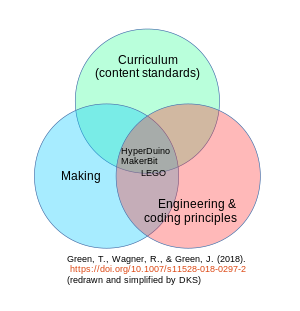Digital design and fabrication for ICT education
Introduction
Digital design and fabrication in education is an emerging discipline, e.g. in the UK under the label "Design and technology". In this page we only focus on the potential of digital design and fabrication to teach and learn ICT skills.
Contents will include citations and summaries that then could be used for further exploration, research and teaching activities. - Daniel K. Schneider (talk) 16:27, 25 May 2018 (CEST)
Digital design and fabrication from different perspectives
Educational robotics
Digital design and fabrication for ICT education most often means assembling a robot from a variety of technologies and the programming it. Some technology, e.g. HyperDuino, Makerbit or LEGO Mindstormsare more suitable to combine making and programming while respecting the curriculum, according to Green at al. who created a little taxonomgy that allows classifying use of tools according to educational outcomes. “The curriculum domain focuses on outcomes that support learners using the tools to understand and demonstrate understanding of content (particularly related to content standardsThe making domain is strongly focused on outcomes that are craft-centric (i.e., making a product). The principles of engineering and coding domain focuses on outcomes associated with coding as the curriculum; learning to use the tools is the primary outcome of this domain. The overlapping of the circles combines the outcomes of the different domains.” (Green et al. 2018)
Since both Digital design & fabrication and ICT education are most often associated with engineering and since educational robotics has long standing tradition starting in Papert's constructionism, it is natural that making is frequently associated with robotics. “Making spans a myriad of activities, including cooking, sewing, welding, robotics, painting, printing, and building (Peppler and Bender 2013). Making activities often involve programming and physical computing (e.g., robotics) that creates interactive experiences of sensing and controlling the physical world with computers (O’Sullivan and Igoe 2014).” (Hsu et al. 2017)
Artistic thinking
Sousa and Pileckki (2013) associated artistic thinking with divergent thinking. “in some STEM classrooms, the students are completing experiments that merely confirm a scientific principle that they have already learned. Such an activity is of little interest and hardly challenging. [...] In divergent thinking, on the other hand, the student generates several ideas about possible ways to solve a problem, often by breaking it down into its components and looking for new insights into the problem. After gaining those insights, the student may then use convergent thinking to put the parts back together and solve the problem in a different and unexpected way. [...] Divergent thinking works best with poorly defined problems that have multifaceted solutions. This is the type of thinking that is typical of artistic activities.”. In more simple terms:
- Convergent thinking solves a problem by applying procedures to known subproblems, i.e. allows to compute a solution with known tools for known problems.
- Divergent thinking creates subproblems. According to Kraft (2007) cited by Sousa and Pilecki (2013), divergent thinking also seems to change the brain itself, i.e. enhance future creativity.
In a way, converting thinking allows to solve difficult problems whereas divergent thinking allows to solve complex problems, i.e. at Andersen and Krathwohl's create level. Both together allow to solve difficult and complex ones.
music requires musical/rhythmic and logical/mathematical skills. Visual art, of course, clearly calls for visual/spatial intelligence. Drama involves verbal/linguistic, bodily/kinesthetic, and interpersonal skills. Dance certainly depends on bodily/kinesthetic, visual/spatial, and interpersonal intelligences. When teachers purposefully incorporate arts-related skills in their instruction, the students’ benefits are abundant.
Constructivism
“The idea that “teaching thinking” is appropriate in elementary school does have some antecedents but in 1970 it was certainly not current in the mainstream of American education circles. I see the movement that goes under names like “thinking skills” and “critical thinking” as something that came to prominence much later and was supported if not inspired by a wave of hype on the lines of “Logo teaches logical thinking.” Reading “Teaching Children Thinking” should show that my own views were much more complex: Pr ogramming can be used to support learning about thinking, which is a very different claim from saying that in itself it improves thinking skills.” (Papert, 2005)
Bibliography
- Anderson, L. W., & Krathwohl, D. R. (2001). A Taxonomy for Learning, Teaching and Assessing: A revision of Bloom's Taxonomy of educational objectives. New York: Longman.
- Davee, S., Regalla, L., & Chang, S. (2015, May). Makerspaces: Highlights of select literature. Retrieved from http://makered.org/wp-content/uploads/2015/08/Makerspace-Lit-Review-5B.pdf
- Green, T., Wagner, R., & Green, J. (2018). A Look at Robots and Programmable Devices for the K-12 Classroom. TechTrends. https://doi.org/10.1007/s11528-018-0297-2
- Hsu, YC., Baldwin, S. & Ching, YH. Learning through Making and Maker Education, TechTrends (2017) 61: 589. https://doi.org/10.1007/s11528-017-0172-6
- Kraft, U. (2007). Unleashing creativity. In F. Bloom (Ed.), Best of the brain from Scientific American: Mind, matter, and tomorrow’s brain (pp. 9–19). New York: Dana Press.
- Papert, S. (2005). You can’t think about thinking without thinking about thinking about something. Contemporary Issues in Technology and Teacher Education, 5(3/4), 366 -367.
- Sousa, D. A., & Pilecki, T. (2013). From STEM to STEAM: Using brain-compatible strategies to integrate the arts. Thousand Oaks: Corwin.
